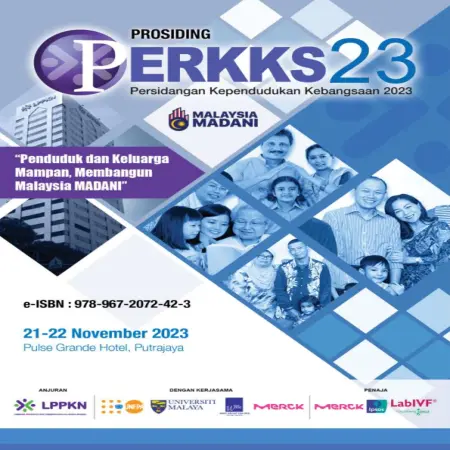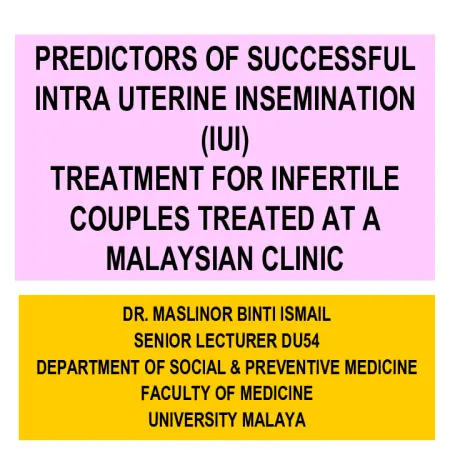TOPICS
Results for Topics : "Fertility"
|
|
Prosiding Persidangan Kependudukan Kebangsaan 2023 (PERKKS 23): “Penduduk dan Keluarga Mampan, Membangun Malaysia MADANI”
Item Type: Book
Editor:
Year: 00/12/2023
Abstract: Collection of papers presented during the 2023 National Population Conference (PERKKS 23), 21-22 November 2023, Pulse Grande Hotel, Putrajaya.
|
|
|
|
|
|
Penurunan Kadar Kesuburan Di Malaysia
Item Type: Infographic
Editor:
Year: 00/10/2023
Abstract: Total Fertility rate (TFR) is a demographic indicator used to estimate the average number of children a woman should give birth to during her reproductive period. The findings of a poll in Sarawak found that the total TFR for the state of Sarawak is decreasing drastically. 12.6% of couples have had or are experiencing fertility problems and it is difficult to conceive within a year after marriage.
|
|
|
|
|
|
Prosiding Persidangan Kependudukan Kebangsaan 2022 (PERKKS 22): “Pemerkasaan Penduduk dan Keluarga, Teras Negara Maju”
Item Type: Book
Editor:
Year: 00/12/2022
Abstract: Collection of papers presented during the 2022 National Population Conference (PERKKS 22), 10-11 November 2022, Bangi Resort Hotel, Selangor.
|
|
|
|
|
|
Penurunan kadar kesuburan penduduk di Malaysia: Implikasi dan intervensi
Item Type: Book Section
Editor:
Year: 00/00/2022
Abstract: The fertility rate of the national population has decreased from 6.8 children in 1957 to 4.9 children in 1970. This rate continued to decline to 3.9 in 1980, 3.3 in 1990, 2.7 in 2000, 2.2 in 2010 and then 1.7 in 2020. The United Nations projects that the fertility rate of the country’s population will remain at a level between 1.7 and 1.8 until 2100.
|
|
|
|
|
|
Penentuan pengaruh Psikostres terhadap kerosakan DNA dan ketakormalan residu sitoplasma sperma manusia
Item Type: Thesis
Editor:
Year: 00/00/2016
Abstract: Idiopathic infertility has been correlated with psychostress which can result in abnormality and declining semen quality in men. Nevertheless, direct relationship of semen quality and psychostress is still unclear. Hence, this study was conducted to evaluate the effect of psychostresson semen quality with emphasizing on sperm DNA damage and cytoplasm droplet abnormality. A total of 628 respondents were selected randomly among men aged between 25-45 years old were patient from LPPKN.
|
|
|
|
|
|
Population and development linkages
Item Type: Conference or Workshop Item
Editor:
Year: 00/00/2014
Abstract: Demographic factors remain very important in the overall development equation, but the meaning of development remains contested, the increasing inequality in many countries’ income distribution provides a fundamental challenge to current economic systems, and the sustainability of what we have achieved remains in question. The United Nations has issued a challenge to academics and planners by claiming that the framework for population and development beyond 2014 should rest on the five thematic pillars of dignity and human rights, health, place and mobility, governance and accountability, and sustainability. Integrating population policy into overall development policy will continue to require both good analytical abilities and a broader vision of what the goals are.
|
|
|
|
|
|
Predictor of successful Intra Uterine Insemination (IUI) treatment for infertile couples treated at a Malaysian clinic
Item Type: Conference or Workshop Item
Editor:
Year: 00/00/2012
Abstract: The purpose of the study was to determine prognostic factors that affect the success rate of Intrauterine Insemination (IUI) as well as association of prognostic factors with success rate of IUI treatment for infertile couples. A retrospective cohort study investigating the prognostic factors affecting success of IUI was done at National Infertility clinic. A total of 1585 couples involving 3249 IUI cycles with ovarian stimulation using clomiphene citrate and/or human menopausal gonadotrophin (HMG) were recruited from lst January 2000 till 3lst December 2006. The pregnancy rate per cycle and per couple was 3.7% and 7.4%, respectively. Logistic regression analysis had determined three prognostic variables as regards pregnancy namely as duration of infertility a = 0.002), interval of menstrual cycle a = 0.00025) and sperm count a = 0.016). The percentage of women successfully pregnant after cycle one till cycle 5 IUI were ranging from 3.4% to 4.8%. Results showed that no pregnancy occurred after the sixth cycle of IUI. The result suggests that duration of infertility is of utmost important determinants of an infertile couple in view of IUI success rate.
|
|
|
|
|
|
Problems of neonatal surgery in Malaysia
Item Type: Article
Editor:
Year: 00/01/1983
Abstract: From January 1970 to May 1981, there were 594 neonates admitted to the General Hospital, Kuala Lumpur for surgery. Three hundred and seventy-one cases bad major alimentary tract alimentary tract abnormalities 97.1 percent of which caused obstruction. High gut anomalies and diaphragmmatic hernia (Group A cases) were relatively uncommon and the overall post-operative mortality for this group was high (64.6 percent). Overall mortality declined from 75.0 percent in 1970 to 10.3 percent for the first six month of 1981. Death rate among the low birth weight infants and those with multiple anomalies however, remain high. Factors related to post-operative mortality are discussed. Foremost among them is the time of referral to the surgeon. Various problems of management in this hospital are also highlighted.
|
|
|
|













